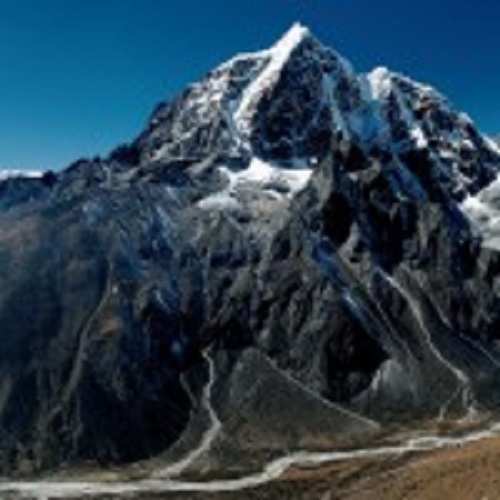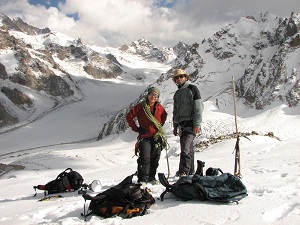Himalayan Glaciers Retreating at Accelerated Rate in Some Regions but Not Others
Posted on 17 September 2012 by John Hartz
This is a reprint of a news release posted by the US National Research Council on Sep 12, 2012.
![]()
Consequences for Water Supply Remain Unclear, Says New Report

Mt. Taboche in the Khumbu Valley, Nepal. Image source: Alton Byers, Khumbu, Nepal, The Mountain Institute,
Glaciers in the eastern and central regions of the Himalayas appear to be retreating at accelerating rates, similar to those in other areas of the world, while glaciers in the western Himalayas are more stable and could be growing, says a new report from the National Research Council.
The report examines how changes to glaciers in the Hindu Kush-Himalayan region, which covers eight countries across Asia, could affect the area's river systems, water supplies, and the South Asian population. The mountains in the region form the headwaters of several major river systems -- including the Ganges, Mekong, Yangtze, and Yellow rivers -- which serve as sources of drinking water and irrigation supplies for roughly 1.5 billion people.
The entire Himalayan climate is changing, but how climate change will impact specific places remains unclear, said the committee that wrote the report. The eastern Himalayas and Tibetan Plateau are warming, and the trend is more pronounced at higher elevations. Models suggest that desert dust and black carbon, a component of soot, could contribute to the rapid atmospheric warming, accelerated snowpack melting, and glacier retreat.

Researchers stand on the Chhota Shigri Glacier in the Indian Himalaya. Image source: Mark W. Williams, University of Colorado, Boulder.
While glacier melt contributes water to the region's rivers and streams, retreating glaciers over the next several decades are unlikely to cause significant change in water availability at lower elevations, which depend primarily on monsoon precipitation and snowmelt, the committee said. Variations in water supplies in those areas are more likely to come from extensive extraction of groundwater resources, population growth, and shifts in water-use patterns. However, if the current rate of retreat continues, high elevation areas could have altered seasonal and temporal water flow in some river basins. The effects of glacier retreat would become evident during the dry season, particularly in the west where glacial melt is more important to the river systems. Nevertheless, shifts in the location, intensity, and variability of both rain and snow will likely have a greater impact on regional water supplies than glacier retreat will.
Melting of glacial ice could play an important role in maintaining water security during times of drought or similar climate extremes, the committee noted. During the 2003 European drought, glacial melt contributions to the Danube River in August were about three times greater than the 100-year average. Water stored as glacial ice could serve as the Himalayan region's hydrologic "insurance," adding to streams and rivers when it is most needed. Although retreating glaciers would provide more meltwater in the short term, the loss of glacier "insurance" could become problematic over the long term.
Water resources management and provision of clean water and sanitation are already a challenge in the region, and the changes in climate and water availability warrant small-scale adaptations with effective, flexible management that can adjust to the conditions, the committee concluded. Current efforts that focus on natural hazard and disaster reduction in the region could offer useful lessons when considering and addressing the potential for impacts resulting from glacial retreat and changes in snowmelt processes in the region.
Many basins in the region are "water-stressed" due to both social changes and environmental factors, and this stress is projected to intensify with large forecasted population growth, the committee concluded. Climate change could exacerbate this stress in the future.
Although the history of international river disputes suggests that cooperation is a more likely outcome than violent conflict in this region, social conditions could change. Therefore, modifications in water supplies could play an increasing role in political tensions, especially if existing water management institutions do not evolve to take better account of the region's social, economic, and ecological complexities, the committee said.
The National Research Council, the operating arm of the National Academy of Sciences and National Academy of Engineering, is an independent, nonprofit institution that provides science and technology advice under a congressional charter granted to the NAS in 1863.
Additional links:
Report in Brief
Project Page
Photo Gallery































 Arguments
Arguments






























As the temperature ramps up, higher and higher glaciers will be retreating. Here in New Zealand, two of our glaciers, Fox and Frans Yosef flow down into temperate zones.
<snip of advertising link>
[PS] Perhaps you were making a subtle point, but the provided link looks like spam to me. Spamming on this site results in instant and permanent ban. I am giving you benefit of doubt this time but you are not spelling Franz Joseph the way a local would so count me highly suspicious.
Hey! Have we got a JAFA for a moderator?
It's Franz Josef!
[PS] Blush! (and I am a southerner not a JAFA).
As a non-Kiwi, I was puzzled as to what a JAFA was. It turns out it refers to residents of Auckland (New Zealand's major city).